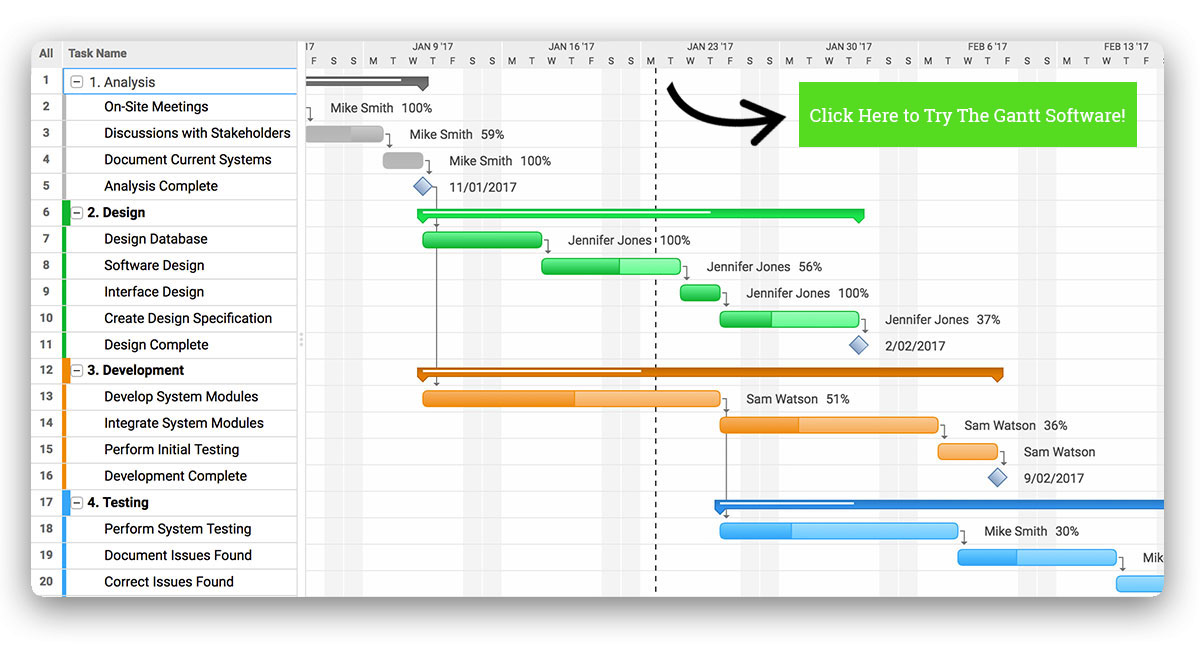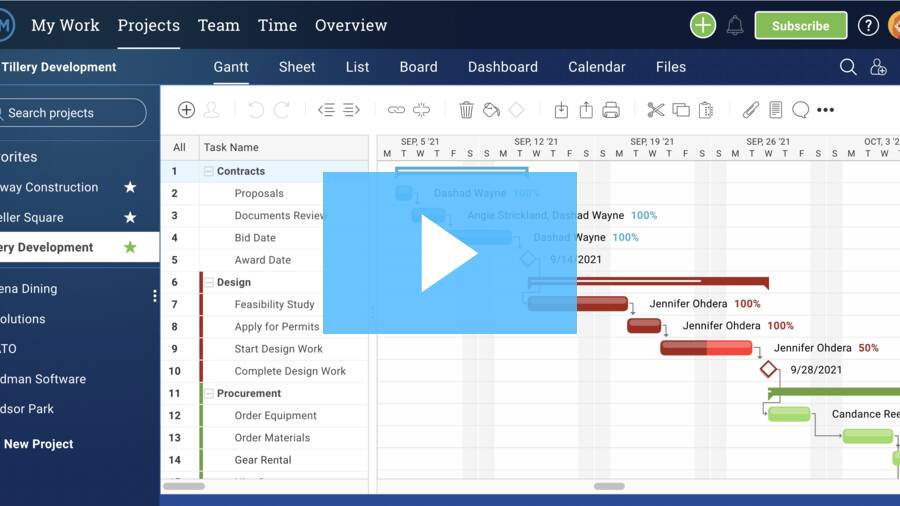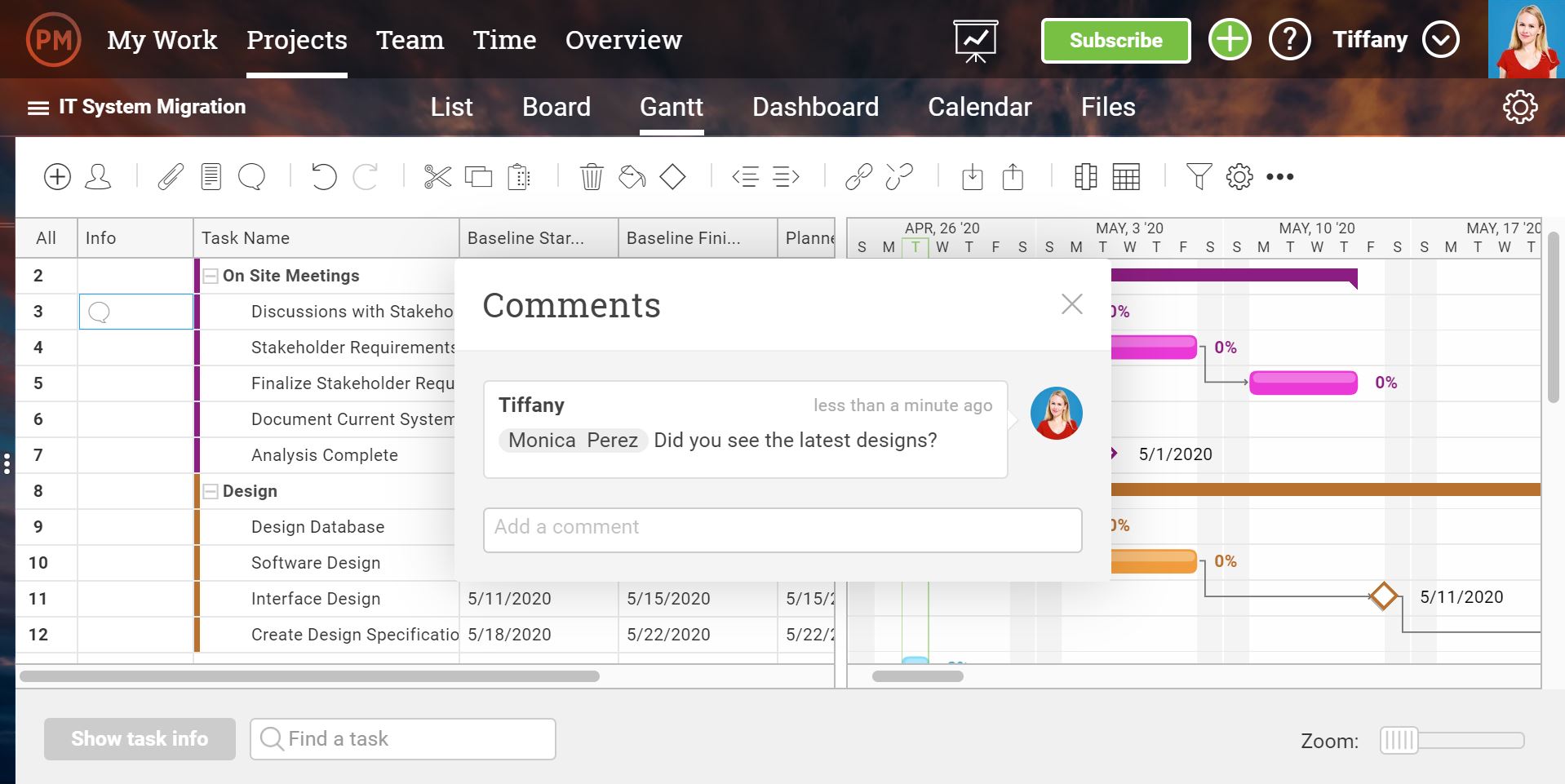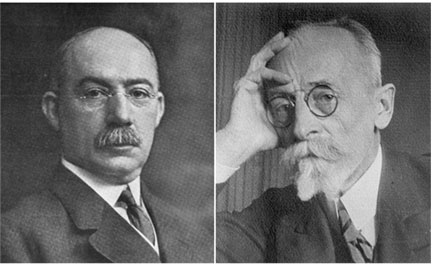How To Create A Gantt Chart In Project
- What Is a Gantt Chart?
- Gantt Chart Example
- What Is Gantt Chart Software?
- What Is a Gantt Chart Used for in Project Management?
- Must-Have Gantt Chart Software Features
- How to Make a Gantt Chart
- Gantt Chart Tips
- Online Gantt Charts FAQs
What Is a Gantt Chart?
A Gantt chart is a bar chart that provides a visual view of project tasks scheduled over time. A Gantt chart is used for project planning: it's a useful way of showing what work is scheduled to be done on specific days. It helps project managers and team members view the start dates, end dates and milestones of a project schedule in one simple stacked bar chart.
Gantt Chart Example

ProjectManager.com's online Gantt chart software.
On a Gantt chart you can easily see:
- The start date of the project schedule
- What the project tasks are
- Which team member is working on each task
- When tasks start and finish
- How long each task will take
- How tasks group together, overlap and link with each other
- Task dependencies, milestones and the critical path of your project
- The finish date of the project
The vertical axis of a Gantt chart shows the tasks that need to be completed, while the horizontal axis represents the project timeline. As you input tasks, their start dates, their end dates and their dependencies, bars on the stacked bar chart will populate, which represent task durations. This happens automatically if you use a project management tool equipped with a Gantt chart maker.
Most Gantt diagrams are created in Excel or with project management software, which is sometimes referred to as Gantt chart software. If you choose to make Gantt charts with Gantt chart software, instead of using an Excel Gantt chart template, then you'll be able to do more than see task durations and due dates.
With Gantt chart software, you can create a work breakdown structure, assign tasks to team members, track project progress in real time and drag and drop timelines to instantly update your project schedule.
What Is Gantt Chart Software?
Watch the video below for a quick introduction to Gantt chart software and its benefits.

Once computers introduced new ways of working, project managers found they could save time in creating and updating their Gantt charts. Gantt chart software, also called project planning, project management, or project scheduling software, was created to automate the process to support more advanced Gantt requirements like creating task dependencies, adding milestones or identifying the critical path of a project plan.
Many project managers traditionally used local desktop programs like Microsoft Project—and many still do. But today, project management software has moved online, enabling anyone to create shareable and collaborative Gantt charts and projects plans.
Desktop vs. Online Gantt Chart Software
Project management software has radically improved the way teams work. Desktop Gantt chart software is best suited for one manager who likes to plan project individually, without a need to easily share the project plan with team members or stakeholders. Similar to managing projects in Microsoft Excel or even Word, desktop Gantt chart software offers one local version per user license.
It becomes hard to share large Gantt or plan file sizes without the enterprise integration of a file sharing hub like Microsoft Sharepoint. Even with Sharepoint, other people you want to share the file with also require the desktop license of the project planning software, which can further increase costs.
Online project management or Gantt chart software supports ease of sharing and collaborative project planning. Because the software is 100% online, anyone you invite can not only see your project plan, but update their tasks and attach files right to the tasks they're working on in real time. And the costs of online project management tools are dramatically less than the desktop versions, because there's no costly server installations, integrations and associated license costs for each user.

ProjectManager.com lets users add comments and files to a Gantt chart—Learn more.
Ultimately, most project managers find the decision to move online with your project planning & Gantt charts is a no brainer, since the productivity gains far outweigh the headaches of older desktop ways of working.
The Benefits of Online Gantt Chart Software
Many people are used to creating task lists in Excel or other spreadsheet tools. They might have created a simple Gantt chart, like we have offered in this free Gantt chart template. This works fine when you're creating a task list of activities for one person to view. When you want to share your project timeline with more people, then it becomes so much easier to create the Gantt chart online. Tasks update whenever anyone changes their % complete or adds a comment or attaches a file in real time. In addition, as a project manager, you can drag and drop project tasks to easily make changes to the project schedule in real time.
What Is a Gantt Chart Used for in Project Management?
The uses of a Gantt chart, as you can see by the sheer number of teams and roles who can benefit from using Gantt charts, are many. Here are just a few:
- Plan & Schedule Projects
- Plan & Schedule Tasks
- Plan & Schedule Tasks across multiple projects
- View Tasks Over Time
- Plan in Sprints
- Team Collaboration
- Resource Management
- Scheduling Teams' Work
- Determining Planned versus Actual Timelines on a Project
There are two halves to most Gantt chart tools you see online today. On the left is a task list column or grid that lists task names and info. On the right there's a stacked bar chart where each task has a corresponding bar that runs horizontally. The task bars start on the date that the work is scheduled to start. The longer the bar, the longer the task will take.
How to Make a Gantt Chart
Whether you choose to draw your Gantt charts, use project management software or download a Microsoft Excel Gantt chart template, you'll need to follow these basic steps:
- Make a task list with all the tasks that are needed to complete your project
- Define the start and end dates for each task
- Create a project timeline based on the duration of tasks
- Identify task dependencies
- Fill out the bar chart timeline with your tasks
- Assign tasks to your team members
- Set milestones
- Identify the critical path
Now that we have covered the information that you'll need on how to make a Gantt chart, let's go through the two most popular methods, project management software and Excel.
How to Make a Gantt Chart in ProjectManager.com
It's easy for anyone to create a Gantt chart online in ProjectManager. You can import a task list from a CSV file, an Excel Gantt chart template, a Microsoft Project file or create one from scratch. Watch as your Gantt bars populate instantly.
Here's a step-by-step guide to creating an online Gantt chart with ProjectManager:
1. Create a new project.

When you first log in, you simply enter in a project name and select "Create".
2. Add tasks.

As you add tasks, the default date will be today, and since you haven't added a longer due date than today, the tasks appear in the Gantt chart tool to the right as circles, representing that they start and end today. The dotted line represents today's date.
3. Add due dates.

As you extend the start and end dates, the task bars on the Gantt chart view extend too, showing you how long each task will take.
How to Create a Gantt Chart in Excel
Creating a Gantt chart from scratch using Excel is a long and complicated process that will require you to do lots of formatting and use advanced formulas. Here's a Gantt chart tutorial you can watch.
However, following this tutorial is difficult for the average user and requires advanced Excel skills. On top of being a labor-intensive process, Excel was not designed to make Gantt charts and therefore lacks many features. Here are the main disadvantages of using Excel to make Gantt charts:
- Your Gantt chart will not be responsive: it's just a static document that must be updated manually every time you need to make changes to your project schedule.
- Excel files must be shared with your team members every time changes are made to the document, which might lead to confusion.
- You can't collaborate with your team in real time using Excel Gantt charts.
- You can't link task dependencies, set milestones or identify the critical path.
If you're not ready to create a Gantt chart in Excel from the ground up, but you still want to try out Excel Gantt charts, you can use a Gantt chart template.
Gantt Chart Templates
You'll find a myriad of Gantt chart templates online, but most of them fall into two main categories; Excel templates and templates made for specific project management tools such as ProjectManager or Microsoft Project.
Luckily with ProjectManager, you can import Microsoft Project, CSV and Excel files to create top-notch Gantt charts that you can use along with all its project management features. Try our Gantt chart template for Excel and import it to our software with our 30-day free trial.
Gantt Chart Tips
How to Use a Gantt Chart to Collaborate with Your Team
Despite the rumors, it's easy to onboard your team with most online project management tools. Once you have invited your team members to the new Gantt chart tool, you can start improving task management in a couple of different ways. You can coordinate a group call to build out the project plan together, right on the Gantt chart view. Or, you can pre-populate the list of tasks into the Gantt, either with an easy import function or cutting and pasting the list, so the tasks and assignments are already populated when your team hops on a call.
Here's how you can easily start collaborating with your team:
1. Assign team members to tasks

You can easily assign or re-assign tasks to team members based on their availability in real time. When people are assigned to tasks, their name appears above the task bar on the Gantt chart.
2. Customize Gantt Charts

You can customize your Gantt charts in whatever way suits your team. Here, you can see that different people are represented by different colors on the Gantt task bars, so it's easy to see at a glance who is responsible for which tasks. Others might use colors on the stacked bar chart to represent different phases of a project or different teams responsible for a group of tasks.
3. Attach Files, Comments or Notes

When your team works collaboratively on an online Gantt chart maker, you can do so much more than just plan tasks. You can add images, videos, links, notes or comments right at the task-level, so all the relevant task work is captured and easily accessible in one place.
4. Get Email Alerts

Your team can customize email alerts in a way that works for them. That way, whenever their tasks have been updated on the Gantt diagram or anywhere else in the system, your team is instantly alerted to that change.
5. See What's New

All the updates on the Gantt diagram can be seen in one view on your Activity page. You can see what the team is working on and when tasks have been updated. Team collaboration is easy with online Gantt charts.
For more tips on how to use a Gantt chart maker, check out our project management expert Jennifer Bridges in this video.
How to Set up Advanced Features in Your Gantt Chart
Gantt Chart Columns
The most common Gantt chart columns are:

- Task name: Unsurprisingly, this is a description of the task.
- Planned start date: This is the date that you aim to start working on the task.
- Planned duration: This is a single number that reflects how many days there are between the planned start date and the planned finish date. It's based on working days, so if a task is planned to take a week it will reflect 5 (working) days on the project schedule.
- Planned effort: How many hours of work the task will take within the duration. Think about painting a wall. It might only take you an hour to paint the first coat but then you've got to leave it two hours to dry before the next coat. Then you paint again and leave it to dry again. That's only two hours of actual painting (effort) but six hours in total (duration).
- Percent complete: A figure, mostly always based on an educated guess by the person doing the task, of how much work they have done and how much is still to do
- Pro Tip: Beware of tasks that stay at 80% complete for too long. This is a sign that the task owner doesn't really know how much work there is still to do. When you ask for updates, the percent complete should move up each time unless no work has genuinely taken place. Monitoring percent complete is a good way to get an early warning about tasks that might run late.
- Assigned: This column tells you the name of the person, people, or resource type (e.g. Developer) who has been allocated to work on the task. At the start of the project you may only have resource type but as you go through you should be able to replace this with the names of actual team members.
- Task Dependencies: You can also show the task dependencies in number form. Choose the "Linked From" column in the column settings. This is often an easier way of quickly finding out the critical path and which task links where. Use the numbers in this column to track back the task dependencies – it can be faster than trying to trace a spidery line on the Gantt chart.
Still not sure about creating links between tasks? Our project management expert, Jennifer Bridges, PMP, explains it all in this video:
These are the most common columns you'll find in project management software, but you can also set your Gantt chart columns to show you virtually anything you want including actual start and finished dates, planned and actual cost and Work Breakdown Structure numbering.
How to Import Gantt Chart Excel Templates
If you've been using Microsoft Excel to create Gantt charts from templates, it might be daunting to let go of that work to switch to online project management software. It's easy to import Excel task lists into online tools to instant populate the online Gantt chart.

1. Find the file you want to import.
You can import simple task lists, Excel files, MS Project files or CSV files.
2. Click "Import."
It's easiest if you match columns in your file with the destination files. The software will help you do this. Use our handy downloadable Excel Gantt chart template in the popup window to easily map your columns. Or when you upload your own files with custom columns, the software will guide you to map your columns.
3. See your tasks represented on the Gantt chart View.
The Gantt diagram auto-populates based on the dates you have added on your task list. If there are no due dates, then the Gantt view will populate with small dots. Simply click on a task bubble and drag to extend its due date on the Gantt charts. Just like that you're scheduling your project online!
Online Gantt Charts FAQs
Gantt Charts History
The Gantt chart was named after Henry Gantt, and many think he was the one who first had the idea of project planning on bar charts. Well, that's not entirely true.

Left: Henry Gantt | Right: Karol Adamiecki
Karol Adamiecki devised the first Gantt diagram back in 1896. He was a Polish engineer turned management professor who came up with the idea of displaying processes visually so that he could make it easier to see production schedules. (He did most of his work in the steel industry.) He called it the harmonogram (a much better word) but Adamiecki published his articles on it in Polish and Russian, so the English-speaking world didn't know much about it.
Henry Gantt had the same idea as Karol Adamiecki, but about 15 years later. In 1910, Gantt started planning visually with bar charts to allow supervisors in the steel works to see if production was on track or behind schedule. It was Gantt's name that got attached to this way of project planning, but today it's generally recognized that Adamiecki had the idea first.
Who Uses a Gantt Chart?
Today, nearly everyone can use a Gantt chart to help them visualize their tasks. Because all the difficult work is now done by project management software, anyone can just create a simple task list, add start and end dates, and the software does the work instantly of displaying your tasks over a project timeline.
Gantt Chart Users by Role
Gantt charts are effective tools for these roles:
- Project Managers
- General Managers
- Team Leaders
- Operations Managers
- Scheduling managers
- Work Managers
- Marketing Managers
- CEOs & CTOs
- … and frankly anyone who wants an instant view of a project timeline.
It used to be that Gantt charts were the exclusive tool of formally trained project managers. These were people planning complex projects, or waterfall projects, of all different types: construction, engineering, military, manufacturing, infrastructure, IT and more. Creating long task lists and complex project schedules with lots of moving parts, required training in the art and science of task management, critical path analysis, baselining and so on.
While still considered the purview of project managers, today with the wide range of project management software and Gantt chart tools, anyone might be found to be using Gantt charts online.
Gantt Chart Users by Team
Because of the collaborative nature of online Gantt chart applications, more and more teams use them to plan and track all kinds of work together. Gantt charts can be used by all kinds of teams, such as:
- IT & Dev Teams
- Project Management Teams
- PMOs
- Marketing Teams
- Professional Services Teams
- Engineering & Architectural Teams
- Construction Teams
- Manufacturing Teams
- Product Development Teams
- Remote Teams
- Telecommunications Teams
- Healthcare Teams
- Public Works Teams
- Oil & Gas Industry teams
- Government Teams
Whereas a project used to have a single project manager leading a single team for a single project, now many people across the organization manage projects with multiple teams of people. And many of those people are working projects under different project managers.
Today's project teams often need to plan tasks and manage resources in multiple projects across different teams, too. It's important to make sure your Gantt chart tools can support resource management, workload management, and task management across projects.
How Does the Gantt Know When the Team is Working?
Planned duration and effort, and the overall start and finish times take working time into account.
The Gantt chart software pulls working time information from the resource working hours that you set. This gives you the option to change the available working time for each team member, which can be handy if you have people who aren't able to work the standard 8-hour day exclusively on your project. You can also change working time for everyone, for example if you're closing the office for a staff event or want to make sure that no one is scheduled to work on a bank holiday.

Is Online Gantt Chart Software Secure?
Many people debating the pros and cons of online versus desktop Gantt chart software wonder about the security of online project plans. Rest assured, most companies offer bank-level security and encryption with online project management software and have multiple security protocols in place to secure data and data recovery. For more information about security at ProjectManager.com, visit our Security page.
Can I Link Tasks to Risks and Issues?
Yes. You can link tasks to risks, issues and changes which makes it easy to navigate in the software and to highlight when a potential problem might need your attention. You can set up columns to display linked tasks and risks with one click.
Can I Customize my Gantt Chart?
There are many ways to customize the ProjectManager.com Gantt chart to suit your way of working. If you don't want all the default options to show – or if you want even more options on display, navigate to the Gantt chart settings of your project management software and select what you want to see.
One of the easiest and most common things to fiddle with is the division of time that is displayed on the Gantt chart. There are two 'levels' of time displayed, normally the week and then the day. You can change the top tier to show weeks, months, quarters or even years and make the lower tier reflect the smaller division of time.

You can also color-code tasks, shade out non-working time and personalize other elements to differentiate by team, phase or anything else you want.
How Do I Print a Gantt Chart?
With care! Gantt charts are often difficult to print because they stretch horizontally over several pages. You used to often see project schedules printed and taped together then hung on the wall, but today most teams try to save the paper and work as far as possible online.
Of course, sometimes you'll need to print out your Gantt chart, or at least a summary of it. Here are 5 tips:
- Print it all on one page if possible. If that makes the text too small to read then
- Change the time divisions so you contract the overall project timeline (and therefore size) as much as possible. For example, if your display is set to show every day, change it so that the time slots shown are weekly or even monthly. That will make the stacked bar chart part of the Gantt much shorter, so it doesn't print on so many pages.
- Roll up your tasks, especially if they are already complete.
- Use print preview: it's annoying to print a lot of pages and then realize you made a mistake! Check it out first.
- Print page numbers if you can, so that you can put the Gantt chart together again if it is on several pages.
The best way to get comfortable using a Gantt chart is to actually create one. Create a project in your scheduling software and play around with it. Practice using the different settings to see which columns give you the information that you want on your project schedule. Your test project file is also handy if you want to try out a new feature or view before you try it on a 'real' project schedule.
The more you use Gantt charts, the easier they will become and the more confident you'll get at using them.

See Why Teams Love ProjectManager.com
Start managing your work your way.
Start a Free Trial
2,000,000+ projects planned, by companies including
![]()

How To Create A Gantt Chart In Project
Source: https://www.projectmanager.com/gantt-chart
Posted by: burtonegary1949.blogspot.com

0 Response to "How To Create A Gantt Chart In Project"
Post a Comment